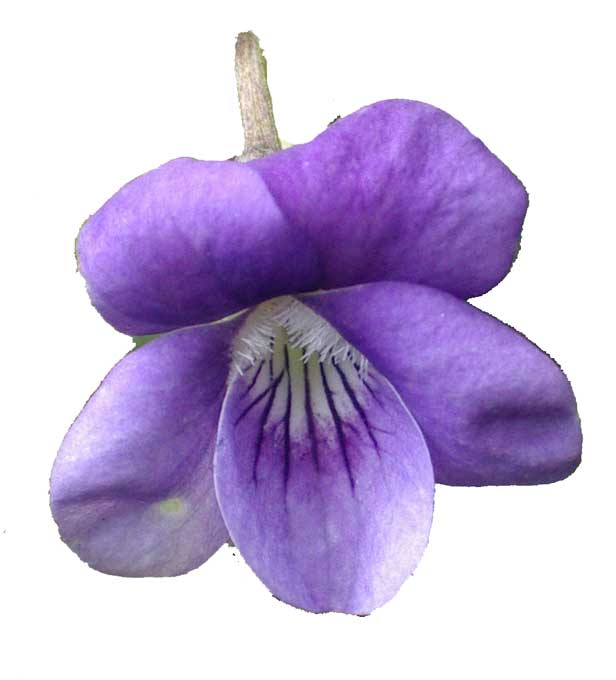 Waterworks
Road & Butterfly
Copse 2005
Waterworks
Road & Butterfly
Copse 2005 Waterworks
Road & Butterfly
Copse 2005
Waterworks
Road & Butterfly
Copse 2005
2 November
2005
 |
 |
 |
 |
After
the rain the
designated footpath (between the Waterworks Road and the Steyning Road,
Old Shoreham) produced a two
mushrooms
growing
in the soil amongst the leaf litter of Field
Maple: Sulphur Tuft, Hypholoma sublateritium,
with gills with a blue tinge and Sulphur
Tuft, Hypholoma fasciculare, with
a yellow tinge to its gills (although this
would not reproduce in a photograph).
Shoreham
Fungi 2005
| 25
October 2005
There were two Common Inkcaps in the Field MapleSpinney between the Steyning Road and the Waterworks Road, Old Shoreham. Shoreham Fungi 2005 The image shows one broken off and inverted. |
 |
20
October 2005
 |
 |
The
designated footpath (between the Waterworks
Road and the Steyning Road, Old Shoreham) produced a two mushrooms
growing in the soil amongst the leaf litter of Field
Maple. I have tentatively identified this
species as the Rooting Shank, Oudemansiella
radicata. The stem was quite strong
and could not be broken easily, although one of the mushrooms was easily
uprooted. The height of the fungus was measured at 90 mm and the cap diameter
as 50 mm.
Shoreham
Fungi 2005
| 4
October 2005
This plant at the southern entrance to the Waterworks Road is a naturalised garden species. It is species of Shamrock, Oxalis. ID by Ray Hamblett (Lancing Nature) The British flora contains one Oxalis acetosella, the Wood Sorrel with lilac flowers. |
 |
27
September 2005
I
did not visit the Waterworks Road but passage through the Butterfly Copse
produced one Red Admiral Butterfly,
one Comma Butterfly,
one Speckled Wood Butterfly,
at least three Common Darter dragonflies,
frequent hoverflies (mostly Eristalis
but also Syrphus),
bumblebees,
blow-flies and Common Wasps.
 |
 |
 |
Another
four Red Admirals
settled on the Ivy next to the Pixie
Footpath in the north-west corner of Frampton's
Fields.
| 6
September 2005
This small moth was easily disturbed and seen amongst the Stinging Nettles in the Butterfly Copse next to the Waterworks Road. 1405 Mother of Pearl Moth, Pleuroptya ruralis ID
by Trevor Boyd on UK-Leps
(Yahoo Group)
|
 |
 |
4 September
2005
The
Waterworks Road hosted a handful of Large
White Butterflies and at least two restless
what were probably Green-veined Whites
(but these butterflies did not settle for confirmation) and a courting
pair of Speckled Woods.
The nearby Butterfly Copse
was disappointing with just a Large White
and a Holly Blue.
The most interesting insect in the late afternoon was what appeared to
be a small reddish-brown damselfly*
from a distance and smaller than a Common
Darter also seen. I attempted to get close
to this mystery insect without success. (*This
is probably just a very small Common Darter Dragonfly?)
1 September
2005
Another
Volucella
zonaria was seen in the Butterfly
Copse next
to the Waterworks Road. There was a small
Syrphus
in
the same copse.
30
August 2005
 |
 |
The
Butterfly Copse with its Stinging Nettles, Ivy, Hawthorn
and Buddleia
played to host to at least one pristine Red
Admiral, two or three Comma
Butterflies, a passing Large
White Butterfly and a Holly
Blue.
Adur
Butterfly & Large Moth List 2005
27 August 2005
The
first Painted Lady Butterfly
of 2005 in the lower Adur valley was seen in the Butterfly Copse by the
Waterworks Road. Other butterflies in the
day included a rich brown Comma Butterfly
on Stinging Nettles on the Waterworks Road, a worn and battered Holly
Blue on Ivy in the Butterfly Copse, with
three Red Admirals,
one worn and battered with a Speckled Wood.
A handful of Large Whites
and Green-veined Whites were
seen over the Stinging Nettles on the Waterworks Road verges.
Butterfly
List for the Day
29
July 2005
Snakes
cannot hear (although they can sense vibrations). This can be unfortunate
for them if they choose to bask on tarmac roads, and this may explain the
death of a Grass Snake
on the Waterworks Road directly underneath
the A27 Flyover
Bridge (at the foot of the old Mill Hill).
The snake was a bit flattened and it measured approximately 65 cm (over
two foot) in length. A Grass Snake
had been seen before (several years ago) on the south side of the
bridge (Pixie Path) on the top (immediately
above) of the downs.
On
a fleeting visit to the Waterworks Road
in the late afternoon where the number of butterflies
were no more than a dozen of five species: a handful of Meadow
Browns, at least three Gatekeepers,
one Comma,
on the road and Maple Spinney, and one Red
Admiral and one Peacock
in the Butterfly Copse, all seen in about ten minutes.
There
were no skippers
to be seen during this brief visit.
23
July 2005
There
were two large dragonflies patrolling the Waterworks
Road and sparring in mid-air. Their thoraces was green and their abdomen
a brilliant blue with black markings. When one settled, I could see that
its eye was a brilliant royal blue.
 |
 |
In flight it was not easy to confidently identify this dragonfly and I was only sure it was Southern Hawker when it settled.
The usual butterflies were present including a count of seven Commas, including at least one smaller than normal fresh specimen which was nevertheless very quick to chase off much bigger Large White Butterflies before returning to its perch on the top of the Stinging Nettles. There was a smaller than usual fresh Speckled Wood Butterfly with a Red Admiral in the Butterfly Copse (next to the Waterworks Road). The other species were a handful both of Small/Essex Skippers, Gatekeepers and Green-veined Whites.
21
July 2005
A
Peacock
is unusual butterfly for mid-July. The one seen briefly in the Butterfly
Copse (next to the Waterworks Road) was faded, but not worn, and flew off
strongly and rapidly. There were five Comma
Butterflies seen, the first one appearing
immediately on Hawthorn. The berries of the
Wayfaring
Tree were reddening next to the footpath by
the Steyning Road.
Butterfly
List for the Day
8
July 2005
Ten
seconds at close range was the only chance I managed of the dragonfly
in a head on view. The bands were light blue and the tail-end of the abdomen
was a continuous pale blue. This is conclusive evidence that the dragonfly
is a Southern Hawker.
Butterflies
included just one Comma.
Butterfly
List for the Day
7 July
2005
This
time the large dragonfly only appeared for about 20
seconds, but apart from the dark blue bands on white, I could not confirm
its identity. In the late afternoon, the first butterfly
seen was Marbled White
on the verges of the A283
Steyning Road on the western side of the entrance to the Waterworks Road.
Because it was both overcast and late in the day, a large number of butterflies
was not expected with half a dozen Meadow
Browns, just the one Comma
seen, a Large White
in the distance, and a Green-veined White
disturbed amongst the Pyramidal Orchids
(near the Steyning Road).
| Yellow
and black flying insects are numerous. They can be difficult to identify.
This one was a Soldier Fly
in the family Stratiomyidae.
There was no yellow on the head of this specimen, the species Stratiomys potamida. The yellow on the head only occurs in the female (which made me doubt my original identification).
|
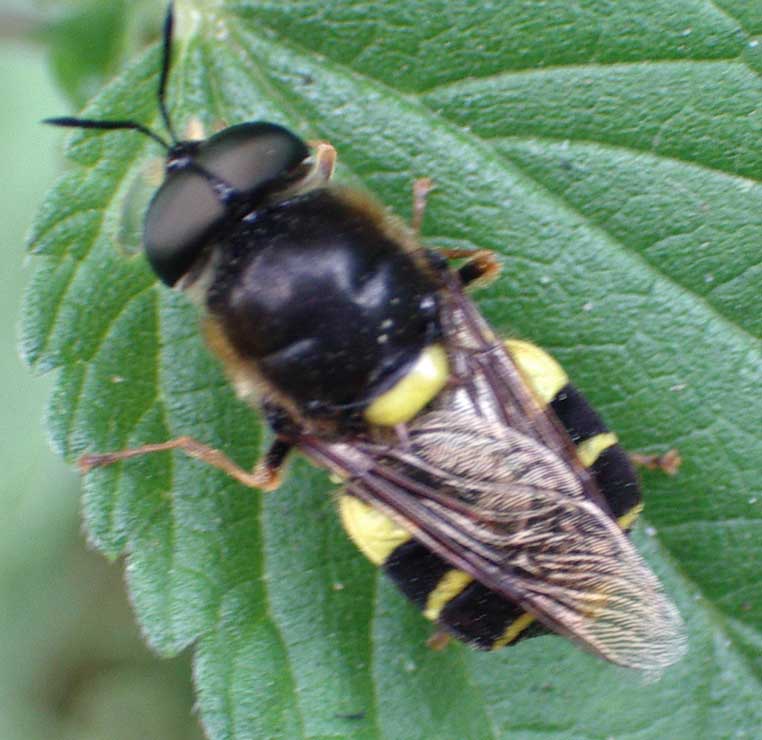 |
 |
7
July 2005
This hoverfly was photographed on Stinging Nettles in the in the Butterfly Copse next to the Waterworks Road and was completely forgotten at the time and the image only discovered on 31 October 2005. The
hoverfly was not immediately identified. The hoverfly was not immediately
identified. It looks like a Volucella
pellucens.
|
 6
July 2005
6
July 2005
An
astonishing 16 Comma Butterflies
were seen on the Waterworks Road (Old Shoreham), and these excluded the
possibility of counting the same butterfly twice. The actual count was
about 30, but is was possible to ascertain the total number seen because
at least ten were counted simultaneously resting on Brambles or Stinging
Nettles as two pairs courted high in the air, with two others seen one
in the Butterfly Copse and one near the Steyning Road. These Commas
were all but two seen on the continual Stinging Nettle borders of the Waterworks
Road, south of the A27 Flyover; a length of road of 100 metres. Only about
five appeared in the first five minutes. Other butterflies
seen in fifteen minutes included one Large
White*, one Large
Skipper (confirmed), three Small/Essex
Skippers (confirmed), two Green-veined
Whites (confirmed) and three Meadow
Browns. A Red
Admiral fluttered strongly over the Butterfly
Copse. The difference in size between the Large
Skipper seen first and the Small
Skipper seen a minute later was distinctive
and obvious. (*This could have been
a Green-veined White?)
Magic
Map Location
Adur
Butterfly & Large Moth List 2005
 |
 |
 |
 |
However,
the reason for making a brief visit to the Waterworks Road was to try and
identify the large dragonfly.
It again put in an appearance of 20 seconds before disappearing, and this
time the fast moving dragonfly looked to have a white abdomen banded in
black or dark blue. Over the Butterfly Copse, another smaller dragonfly
was probably a Common Darter,
but this was active and restless and zoomed off before I could get a good
look.
Hoverflies
included the species Helophilus
pendulus on and around the Stinging
Nettles and the bumblebee mimic Volucella
bombylans var. plumata
was instantly spotted at the western entrance to the Field
Maple Spinney.
In a small overgrown patch by the A283 Steyning Road before the footpath continues through the Field Maple, the small Self-heal plant (image above, far left) was very frequent, nearly a hundred flowers amongst White Clover.
2 July
2005
Overcast
but without the rain, five Comma Butterflies
were quickly seen amongst the Stinging Nettles in the Waterworks Road,
probably the same ones seen three days ago and one even landed on me.
 |
 |
 |
 |
It
sheer size, made it almost certainly a female Emperor
Dragonfly* (the one seen before)
that patrolled over the Butterfly Copse next to the Waterworks Road. There
is still the possibility is a Southern Hawker
though. It remained for less than a minute after which time a variety of
hoverflies
and two Magpie Moths
disturbed amongst the Stinging Nettles and one Meadow
Brown Butterfly appeared with a single
Common
Blue Damselfly.
One yellow and
black hoverfly (perhaps
a wasp or a bee or a soldier fly?) was unfamiliar
but it flew away before it could be photographed. Another hoverfly was
Volucella
inflata which I have only just been
able to recognise.
Adur
Flies
1
July 2005
The
large dragonfly was patrolling like before
on the eastern verge above the Stinging Nettles, about 30 metres north
of where the footpath crosses the Waterworks Road at the southern end.
It estimated speed must have been about 19 mph, and it visibly wilted after
it was hit by a rain drop and then darted under the hidden cover of the
Sycamore wood as the rain poured down. However, this time I was able to
get a slightly better view and I would still estimate the total length
of the dragonfly to be at least 75 mm. The thorax was bright green but
the abdomen was now seen to be dark blue patterns on a white background
and without any yellowish tint on an overcast day.
This
large dragonfly is either a female Emperor
or
a female Southern Hawker,
and I have had this identification problem without resolving it at least
three times before. The size is difficult to estimate with such rapid and
unceasing flight. * A subsequent observation of a
dragonfly on Mill Hill makes me think this
is probably a Southern Hawker.
Report
of Southern Hawker
29
June 2005
Despite
being patient, I was still unable to get close enough to get a clear view
of a large dragonfly with a bright yellow-white
banded abdomen that patrolled the Waterworks Road, north of Old Shoreham,
in bright sunlight. It moved so rapidly and darted in so many different
directions, from one metre off the tarmac road surface to four metres up
into the Sycamore leaves within a second or two, that I could not get a
fix on it. It eventually settled after about three minutes but by the time
I retrieved my binoculars I could not find it again. The dragonfly was
at least 75 mm in length. Its identity remains unknown.
Suggestions:
Have
you considered immature female Southern
Hawker? The coloured areas can be quite
yellowish in the immature stages.
I
did get my reward of the my first ever sighting of the brilliant blue abdomen
of the Beautiful Demioselle,
Calopteryx
virgo, with
its large dark wings which I could see as it settled underneath a Sycamore
leaf four metres above the Stinging Nettles. It looked a bit like a butterfly
at first glance until the brilliance of the blue abdomen became apparent.
Adur
Damselflies and Dragonflies
With
a noisy squawk a splendidly coloured Green
Woodpecker
was seen close up as it flew in a semi-circular flight over the Waterworks
Road. Stinging Nettles were the abundant dominant flora on the verges of
the road.
 |
 |
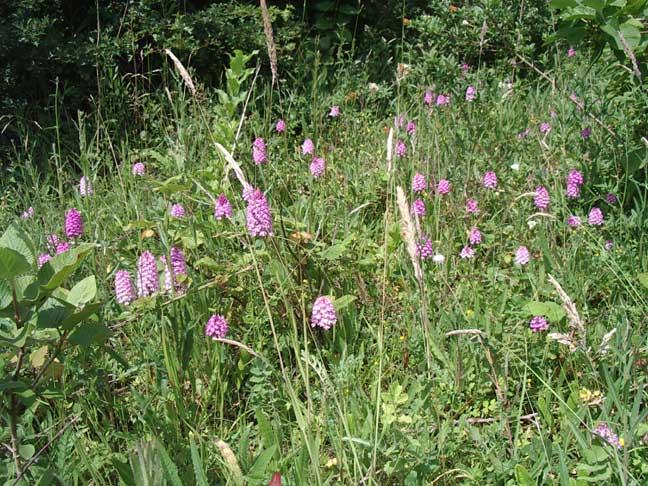 |
Comma
Butterflies were very prominent with eight
different butterflies seen (and possibly as many as ten as twelve were
counted, but two were definitely the same butterfly twice and two others
probably were as well). There was one worn and slightly damaged Red
Admiral amongst the nettles, a Large
Skipper confirmed (and one that looked
like a Small Skipper in
flight), two Meadow Browns,
about half a dozen Large White Butterflies*
and two smaller white butterflies, probably Green-veined
Whites?. There were two fresh
Speckled
Wood Butterflies in the Butterfly Copse
next to the Waterworks Road. It was only a passing visit, prolonged because
of the large dragonfly. A Burnet Moth
was seen out of the corner of my eye.
(*These could have been Green-veined Whites?)
Butterfly
Report for the Day
In a small overgrown patch by the A283 Steyning Road before the footpath continues through the Field Maple, Pyramidal Orchids were common, over hundred in flower.
23
June 2005
There
was a fresh orangey Comma Butterfly
that was very flighty amongst the Stinging Nettles, three Large
Whites, a Meadow
Brown Butterfly on the Waterworks Road
and a Speckled Wood
in the Butterfly Copse.
Adur
Butterfly List 2005
20
June 2005
A
distinctive hoverfly, the bumblebee
mimic Volucella
bombylans var. plumata
was instantly spotted at the western entrance to the Field Maple spinney
(hereafter
called the Maple Spinney) footpath between
the Waterworks Road and the Steyning Road. This hoverfly seems to be frequently
seen (over 12 records) in June.
| 18 June 2005 | Slow Worm |
The
Slow
Worm was resting in the shade on the road
near the beginning of the footpath to Mill
Hill (before the Butterfly Copse). where there was lot of Wren
activity by one of these small birds, but others were calling.
 |
 |
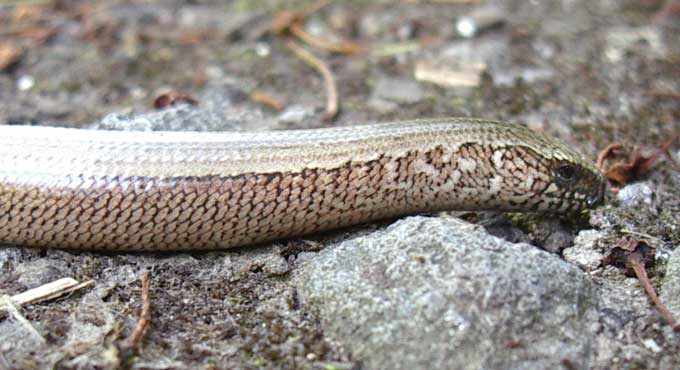 |
 9
June 2005
9
June 2005
A
Common
Blue Butterfly settled on a Stinging Nettle.
In the horse's field nearest to the Waterworks House, the grass and flowers
seemed to had been cropped too short for any signs of the Bee
Orchid. There was a few clumps of Red
Campion.
15
May 2005
The
Squash
Bugs,
Coreus, were mating and the
usual butterflies were around.
2 May
2005
It
was a beach day,
but I did make a brief foray to the Waterworks Road to try and get a photograph
of an Orange Tip.
I could not get within seven metres of two pairs of Orange-Tips,
with
a three Green-Veined Whites,
one Large White
still chasing them and a Peacock Butterfly
in
the late afternoon.
Adur
Butterfly List 2005
1
May 2005
Unlike
two days ago, when I arrived at the southern end of the Waterworks
Road, there were no butterflies
to greet me. I dallied around to get some better photographs of the dozen
or so Rhingia campestris
Hoverflies and got distracted by the arrival
of two Green-veined White Butterflies which
got chased off by a Large White Butterfly
twice their size. It
was an interesting comparison.
A Holly Blue Butterfly
was the first to appear and I nearly trod on a Peacock
Butterfly which was resting. The weather
was a bit dull at the time. A single Speckled
Wood Butterfly was seen in the Butterfly
Copse (by the steps on the footpath
to
Mill Hill). Buff-tailed
Bumblebees and
Carder
Bees were noted. A Common
Bee-Fly,
Bombylius
major, posed for a picture. The 14-spot
Ladybird,
Propylea quattuordecimpunctata,
rested
on a nettle.
 |
 |
 |
 |
TheRhingia hoverflies have been identified as Rhingia campestris. This is the most frequently encountered of the two Rhingia.
29
April 2005
 I
knew was going to be a good day when I saw four species of butterfly
in a minute on the Waterworks Road.
The four Brimstone Butterflies,
itself a local record together, four white
butterflies including both confirmed Green-veined
and Small Whites
and two Peacock Butterflies
in the first thirty metres was unprecedented.
I
knew was going to be a good day when I saw four species of butterfly
in a minute on the Waterworks Road.
The four Brimstone Butterflies,
itself a local record together, four white
butterflies including both confirmed Green-veined
and Small Whites
and two Peacock Butterflies
in the first thirty metres was unprecedented.
Hoverflies and bumblebees visited the White Dead-nettle, Dandelions and Green Alkanet. One of the hoverflies had an upturned snout indicating the genus Rhingia. Squash Bugs, Coreus, were common, probably over a hundred in an area of ten square metres on nettles with a handful of Nursery Web Spiders and many more spiders were likely to be hiding.
As
usual, the Brimstone Butterflies
were reluctant to settle. When the one in the photograph on the right did,
it chose the underneath of a leaf and it was difficult to spot. Then the
batteries ran out on my camera and I felt the first spots of rain.
It
was about an hour later that I returned to find all the butterflies and
most of the flying insects had disappeared.
 |
 |
 |
 |
There was a Peacock Butterfly on the Pixie Path. and then a dark Common Lizard with a full length tail skittered rapidly over the fallen lichen-covered broken fence as a Pill Bug (the wood-louse that rolls up into a ball) crawled amongst the Cladonia Pixie Cups.
27
April 2005
The
first Milkwort
flower and the first Common Mouse-ear
of the year were seen on the side of the Pixie Path to Mill
Hill.
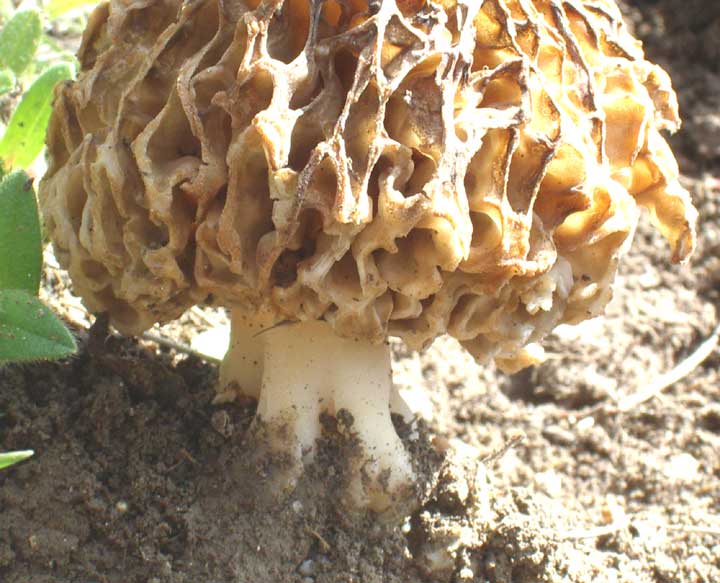 18
April 2005
18
April 2005
The
strange and unusual looking Morel
Mushroom,
Morchella esculenta,
was
seen on the side of the Pixie Path to Mill
Hill. It looked dried out but I expect
they always look like this. There were small orange ants around the base
of the mushroom.
Fungi
of Shoreham
16
April 2005
A
female
Sparrowhawk actively hunting at the southern
end of the Waterworks Road in the back gardens of the houses, before the
cliff descends vertically, was a handsome sight. I noticed the fanning
of the tail feathers as it stalled before landing or striking (out of view). The
identification of the Sparrowhawk was not definite, the brown colouring,
the tail wings fan, the size and the behaviour, low level flying and gliding
and turning rapidly in a small area, indicated Sparrowhawk, but the barring
could have been a female Kestrel, possibly, which have been known to behave
in this way on frequent occasions in autumn.
Just
before this as I descended the footpath from Mill
Hill I spotted two corvids
in a single tree, one was a Jay
and the other was a Crow,
and then a Magpie
appeared.
15
April 2005
Dog
Violets were the only violets
now on the Pixie Path to Mill
Hill. Flying
insects were numerous
including bumblebees, a few hoverflies,
flies
and mining bees. There was an obliging Holly
Blue Butterfly and a gall
of some sort.
 |
 |
 |
10
April 2005
The
first dozen Dog Violets
were in flower on the Pixie Path to Mill
Hill, but on the lower slopes of Mill
Hill the Sweet Violet
was still the dominant flower with tens of thousands.
 |
 |
The
white spur and pointed sepals leave no question about the identification.
Adur
Violets
3 April
2005
It
was shirt sleeves weather in the afternoon sunshine on the warmest
(17.5 ºC) day of the year.
 |
 |
At
the turn (where the stile used to be) on the Pixie
Path to Mill Hill, the first Common
Lizard,
Lacerta viviparus, of the
year basked in the sun on a moss covered broken fence. The lizard's tail
seemed short than its full size. The lizard may have lost part of its tail
and regrown it by a process called autotomy.
Lizard
Images File
1 April
2005
A
Great
Tit in the Hawthorn and other bushes on
the road embankment next to the Pixie Footpath flew across the road
to the bushes on the Mill Hill side of the A27
Main Road. One of the Forget-me-Nots
were in flower next to the Cladonia
Pixie Cup lichens.
 |
 |
There was a moth resting on the fence in the Butterfly Copse as photographed above. It assume that is nocturnal moth resting up during the day as it did not fly away when poked, but dropped to the ground. This moth is the Early Grey, Xylocampa areola. The yellowish-brown larvae feed on Honeysuckle, Lonicera.
18
March 2005
A
Small
Tortoiseshell Butterfly was disturbed
basking in the midday sun on the Pixie Footpath adjacent to the
horse's fields on the way to
Mill Hill.
It was probably the one from two days ago and it was in the same place
on the bridleway section parallel with the A27
Main Road but it appeared darker and flew
off
and disappeared when disturbed just like before.
 |
 |
 |
 |
16
March 2005
A
Small
Tortoiseshell Butterfly was disturbed
basking in the midday sun on the Pixie
Footpath adjacent to the horse fields
on the way to Mill Hill, and I was quick
enough to make a positive identification. This is the second probably of
the day and the first confirmed local sighting of 2005.
 |
 |
 |
 |
|
|
Mosses
and lichens (above) on fallen fences proved
difficult to photograph because of their small size and their apparent
preference for the shade.
Pixie
Cups and other epixylic organisms
(Local Link)
 The
first ladybird of the year was a 7-spot
Ladybird, Coccinella septempunctata,
in the Butterfly Copse (near the Waterworks Road). I saw three ladybirds.
They remained still and did not fly off when teased.
The
first ladybird of the year was a 7-spot
Ladybird, Coccinella septempunctata,
in the Butterfly Copse (near the Waterworks Road). I saw three ladybirds.
They remained still and did not fly off when teased.
Adur
Ladybirds
27
February 2005
The
Pixie
Cups (see below) were surrounded by a
thin layer of snow.
8 February
2005
A
spell of sunshine around midday at sea level turned to mist on the gentle
climb to Mill Hill. Not expecting much
natural life, my attention was drawn to the growths on some broken fences
that had been left to rot. The various unidentified mosses, lichens etc.
are illustrated below. The photograph on the right shows the podentia of
a CladoniaPixie
Cup Lichen.
 |
 |
 |
The
fences were to the north at the top of the path as it passed by the large
(three metres high plus) hedge on the southern side that formed the garden
boundary. This means that they were in the shade.
More
Images
Waterworks
Road and Butterfly Copse 2004